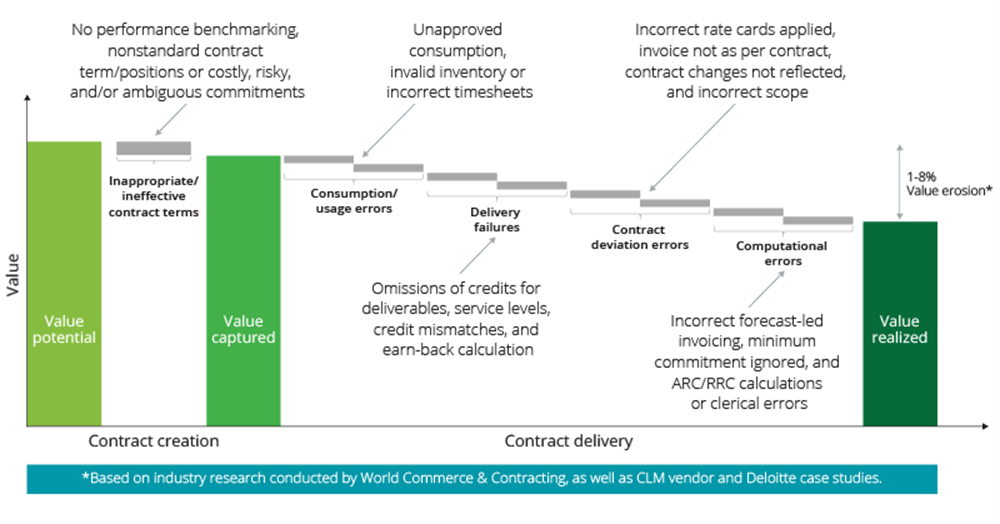The revolution in post-signature contract management has been saved

Perspectives
The revolution in post-signature contract management
Realizing value through management of executed contracts
In many organizations, contracts are about one thing: getting to the signature. But the phase that begins after execution is where contractual value is truly won or lost. In this article, we unpack the strategic, financial, and operational benefits that can accrue from effective management of the post-signature process.
Coronavirus: The catalyst
When the COVID-19 pandemic hit, the demands on post-signature contract management exploded. Customers and suppliers raced to:
- Understand the status of performance
- Seek variations to terms
- Identify rights, obligations, and the implications of contract change and amendment
Companies needed to know whether they, their customers, or suppliers could renege on contractual commitments. The necessity for transparency and clarity of contractual obligations, rights, and reliefs was thrown into sharp relief.
In this article, we discuss why obligations management is such a critical phase of the contract life cycle, and how post-signature is where the value of contract management is truly won or lost. By understanding this, contracts may be seen for what they are—a strategic business asset—rather than just a legal document.
The end-to-end process
Contract management is the process by which businesses manage the life cycle of their contracts. Many customers and suppliers spend most of their time and effort focusing on winning that deal, drafting, and negotiating that contract—all staple pre-signature activities—yet may neglect the equally, if not more critical, post-signature phase activities.
“Post-signature” refers to the activities that can or should occur after a contract is signed. To be clear, these are contract management activities, but they may not be getting appropriate attention and focus. You can segment these activities as:
- Compliance with the legal components of contractual relationships, such as notices, change orders, renewals, and amendments
- Commercial obligations, such as invoicing, discounts, and performance management—frequently referred to as commercial management
Post-signature activities are often set aside until the eleventh hour, or just until an unexpected pandemic forces everyone to take notice.
Contract management post-signature
When we say post-signature, what exactly are we referring to? The answer includes:
- Ensuring compliance with the terms and conditions (getting the value bargained for)
- Managing contract amendments
- Adhering to production, quality assurance, packaging, and delivery requirements
- Resolving claims and disputes
- Measuring commercial performance
Post-signature activities fall into two buckets:
- Compliance with contractual and regulatory obligations, change order and dispute processes, notices, renewals, amendments, and reporting (contract management)
- The more financially focused activities, such as performance, pricing adjustments, invoicing, and discounts (commercial management)
According to the World Commerce & Contracting Association (WorldCC), 9.2 percent of annual contract value is lost through poor management across the whole life cycle, with the majority of that lost value occurring in the post signature phase. This is consistent with what we might expect amid post signature issues like price changes, invoices, late payments, service levels, discounts, and auto-renewals.
Knowing what the contract says is just the start to finding value. The real value perhaps comes from avoiding the “value gap” that can arise when the anticipated benefit at the start of the arrangement gradually erodes over time.

Effective obligation management is not just about the legal and commercial obligations but also how this information interacts with the information in the organization’s financial and human resource systems.
All of this information is, of course, impacted by the burgeoning and ever-changing regulatory environment. Within the past 24 months alone, a slew of activity around interbank offered rates (IBOR), Brexit, new data privacy laws, etc. has had a significant impact on contracting. For example, the global financial industry is scrambling to understand the implications of IBOR changes on existing contracts.
As challenging as they are to manage, regulatory changes are at least hard to ignore. Contractual obligations to a partner or supplier are a different matter. Many companies simply track the parties and the end dates, but not the notice period to terminate or stop an auto-renewal. The result is that many have accidentally renewed something they did not need and paid cash for something that was never used, simply because they failed to track the one foreseeable part of this equation.
Because of the complexity of contracts, these types of mistakes can be made frequently. Perhaps it is time to think of a contract as an asset that, if monitored correctly, can profit the entire organization. After all, contracts are not just legal documents. They are strategic business assets that happen to contain both legal and commercial terms and conditions.
Most contracts have mechanisms for handling changes, expansions, and reductions. But oftentimes, companies simply create a change order for every perceived change in scope of timing without scrutinizing the already agreed-upon mechanisms. This may not be ideal, as it can lead to inadvertently one party paying for something twice. On the other side, change orders are a natural part of any long-term relationship, and the absence or infrequency of a change order can actually be an indicator that the scope is lacking oversight.
Without the right staffing, process, or technology to help manage these types of issues, companies run the risk of losing out, paying too much, recovering too little, or just souring a relationship. If you invest to create something, it only stands to reason that you invest something to make sure it lives a healthy life.
Companies need to dig into their contracts and contractual relationships and evaluate whether they are receiving the value they signed up for.
Understanding the business needs is merely the beginning. Businesses must also monitor financials and performance in the post-signature phase. Once they do, they may be able to see an impact on their bottom line.
For many organizations, the challenge is being able to show value and return on investment. When technology meets humanity: The future of contract management, a report by Deloitte and WorldCC, shows that only a third of companies can provide some measure of the financial value or business impact of their contract and commercial management investment. More concerning, only a little more than 20 percent attempt to monitor or calculate the costs or overall benefits associated with contract management. 2
Here are some concrete examples of how effective post-signature management can enhance value:
• Avoid invoicing errors
• Avoid paying for unachieved service levels, deliverables, or outcomes
• Avoid purchasing goods or services that are available but are not needed or are duplicative to what is already in scope
• Max out earned credit or negotiated discounts
• Avoid nonadherence to payment terms that can affect cash flow
• Avoid failure to bill for contractually required and delivered work
Effective management of post-signature obligations may also allow companies to:
• Decrease compliance risk and administrative burden
• Enable better tracking and monitoring of existing contract service level agreements and KPIs
• Share knowledge between information within the contracts and the organization or piece of the organization actually utilizing the services or goods
• Enhance the value proposition from third-party relationships
The present
Less than 30 percent of organizations have centralized or center-led post-signature contract management resources.3 By diverting most of their resources to the pre-signature phase, many companies leave few to none to contest the real battle that begins post-signature. Sealing the deal is important, but so is profit—and it is in the post-signature phase that profit is best mined.
However, the balance of focus across pre-signature versus post-signature has begun to change.4 Today, companies are investing in a number of key areas:
- Analyzing, assessing, and reengineering the post-signature processes
- Introducing more comprehensive and robust approaches to legal and obligation management
- Investing in the multidisciplinary and cross-functional talent needed to improve post-signature contract management
- Investing in contract management technology
Many organizations are now thinking beyond the data found within the contract itself and focusing on how it can be linked to enterprise data contained in financial, HR, procurement, and customer relationship management systems. Thirty-nine percent of companies report that they are improving post-signature processes, and 25 percent state that they are increasing the role of commercial professionals in post-signature risk management.5
Companies may want to consider approaching contracts more broadly. A broad-based approach marries process standardization, automation, global delivery, alternative resource models, and continuous improvement. For a successful transformation to occur, organizations also may need to use technology to support other aspects of change within their organization, including:
- Digitization of the contract portfolio
- Analysis and understanding of the pain points across the entire life cycle
- Development of contract data standards
- Quantifying the overall cost per contract to the organization
- Consolidation of resources
- Increasing clarity over organizational roles and responsibilities
Without the proper investment in people, process, and even content, the best technology may only offer a temporary fix.
The next frontier
Contracts are a well of data that can be used throughout the organization and sourced for profit. They provide a framework for mutually beneficial business outcomes and generate economic value. They are also tools for risk management, with a formal record of rights, responsibilities, and obligations. Finally, contracts can provide intelligent insights to the overall business and even be a testament to an organization’s brand and corporate values. Meanwhile, the contracting process is an opportunity to collaborate both within the organization and externally.
With a change in the way contracts are seen, a change in overall perception of the post-signature phase will likely follow. The future starts with elevating our view of contracts and remembering that contracts are not just legal documents but so much more—they are strategic business assets that merely happen to contain both legal and commercial terms.
1 Tim Cummins, “Poor contract management costs companies 9 percent—bottom line,” 2 World Commerce & Contracting (WorldCC) blog, October 29, 2012.
2 Deloitte and WorldCC, When technology meets humanity: The future of contract management, February 2021.
3 Deloitte and WorldCC, When technology meets humanity.
4 Ibid.
5 Ibid.
Learn more about Deloitte’s Legal Business Services
The rapidly changing business landscape has intensified pressure on legal departments to increase efficiencies and deliver greater value to the business. Deloitte’s Legal Business Services helps clients modernize their legal departments, freeing the core legal team to focus on strategic priorities, enhance the speed and quality of issue identification, and use data to drive faster, more informed decision-making.
*The Deloitte US firms do not practice law or provide legal advice
Get in touch
 |
Mark Ross |
 |
Craig Conte |
 |
Jonathan J. Luciano |
Recommendations
Contract and commercial management
When technology meets humanity
Tech Bytes 4: Intelligent CLM systems
Bending the iron triangle for real contract cycle time improvements


